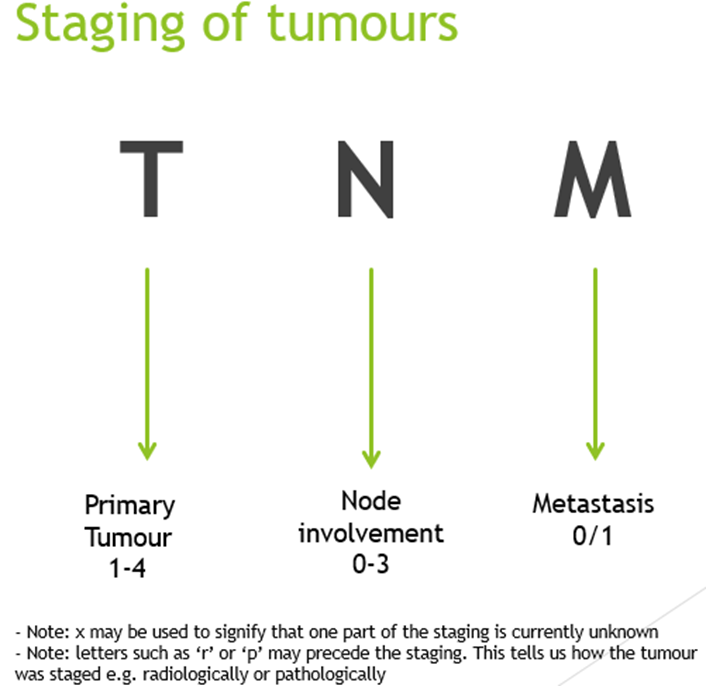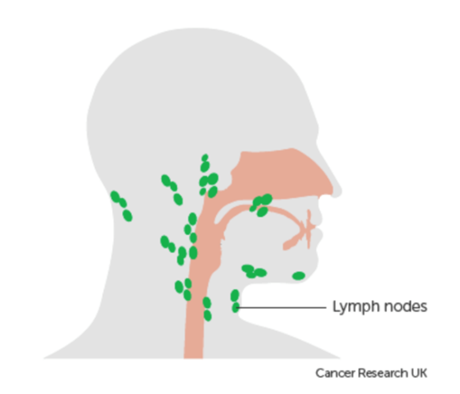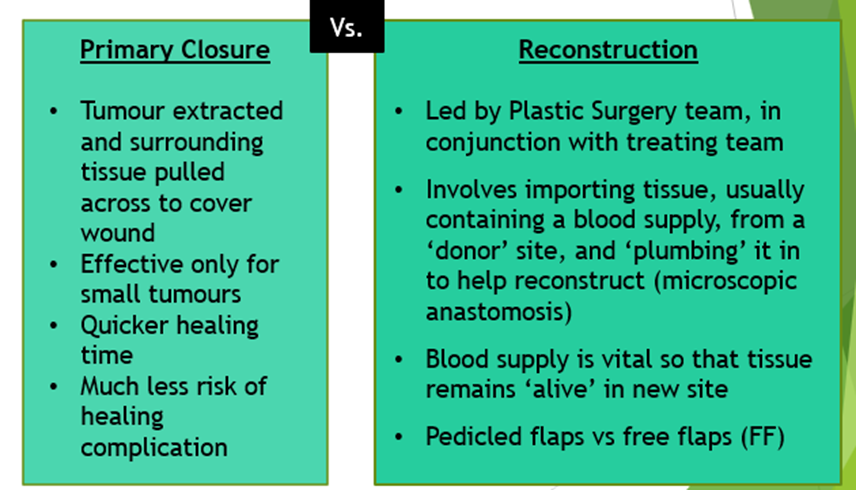ENT: Head and neck cancer
1/13
There's no tags or description
Looks like no tags are added yet.
Name | Mastery | Learn | Test | Matching | Spaced |
|---|
No study sessions yet.
14 Terms
What are the 3 stages of tumours? TNM

What are the lymph nodes? what are they for?
• Lymph nodes are part of the body’s lymph system
• Several groups of nodes (small bean/grape-shaped nodes) positioned around our body in areas such as neck, armpit, groin, chest
• Part of the immune system
• Help to fight infection and inflammation

What are the 5 types of brain tumours? GNAMM
Glioblastoma, Neuroblastoma, Astrocytoma, Meningioma, Metastases
What are the features of the 5 brain tumours: Glioblastoma, Neuroblastoma, Astrocytoma, Meningioma, Metastases
• Glioblastoma – originates from astrocytes in the brain, highly aggressive, mostly found in cerebral hemispheres
• Neuroblastoma – starts from either the adrenal gland or from nervous tissue
• Astrocytoma – originates from astrocytes in the brain, aggressiveness depends on grade, can occur in brain and spinal cord
• Meningioma – within the meninges
• Metastases (e.g from lung Ca, breast Ca) – cancer cells spreading from the original tumour to other parts of the body
Effects of tumour on speech/ swallowing?
• Structural changes to articulators
• Structural changes to resonance chambers
• Structural changes to swallowing mechanism
• Space-occupying lesions may disrupt the breathing/ swallowing/ phonation process
• Pain, appetite, weight, etc.
Treatment options for cancer?
• Radiotherapy
• Chemotherapy
• Chemoradiation
• Surgery
• Surgery + radiation/ chemotherapy
• Treatments may be curative or palliative
Speech and swallowing can be worse after treatment – radiotherapy can produce more probs before things start to get better
What is Iatrogenesis?
Iatrogenesis – the unintentional cause of a health condition during the process of providing healthcare.
Speech and swallowing can be worse after treatment – radiotherapy can produce more probs before things start to get better
Primary closure vs reconstruction?

Common donor sites for flaps
• Radial forearm (inner forearm) (RFFF)
• ALT (antero-lateral thigh) (ALTFF)
• Pectoralis major (chest) (PMPF)
• Scapula (back/shoulder) (SFF)
Donor tissue retains original properties e.g., skin colour, texture, hair growth
Effects of treatment on speech and swallowing: surgery
• Change in anatomy - missing because of surgery or erosion by tumour – additional anatomy e.g., skin flaps on tongue – change in anatomy may then impact the physiology of the swallow or of speech production.
• Loss of function
• Swelling
• Pain
• Tracheostomy
• Psychosocial issues
Describe radiotherapy and its features
• Can be given as a primary treatment or as an adjuvant treatment
• Kills cancerous cells using high-energy radiation; cells then regenerate with healthy tissue
• Also kills off many healthy cells, hence nasty side effects (‘toxicity’)
• Advancements in Radiotherapy (e.g. Intensity modulated radiotherapy – more accurate to site of tumour) have increased accuracy of RT treatment fields, so less healthy surrounding tissue affected.
• You can only have RT to the same area once.
• Effects continue after treatment has stopped
Effects of radiotherapy on speech?
• Mucositis – inflammation and ulceration of the mucus membrane
• Pain
• Erythema – redness of the skin or mucus membrane
• Xerostomia/ altered saliva – “dry mouth”, saliva glands do not produce enough saliva
• Oedema – swelling caused by excess fluid trapped in body’s tissue
• Fatigue
• Fibrosis – scarring of tissue
• Psychosocial issues
Describe chemoradiotherapy and its features
Chemotherapy is the use of cytotoxic drugs to destroy cancer cells
In head and neck cancer, chemotherapy is used:
In combination with radiotherapy (‘concurrent chemotherapy’)
Before surgery to shrink a tumour (‘neoadjuvant’ chemotherapy)
To relieve symptoms and improve quality of life (palliative)
Chemotherapy is not commonly used on its own as a primary treatment for head & neck cancers
However, is sometimes used alongside RT to increase the sensitivity of the tumour to RT (i.e. Radiosensitiser)
• Usually delivered for one day per week, intravenously (e.g. on chemo day unit)
• Not associated with the hair loss - often accompanied by nausea
• Only usually used with relatively young, fit patients (typically age <60/65 and good performance status (WHO)) as hard to tolerate (heightens RT toxicity)
Effects of chemotherapy on speech
• Fatigue
• Nausea/ vomiting
• Reduced appetite
• Infections
• Sore mouth